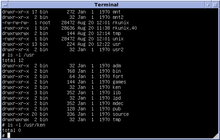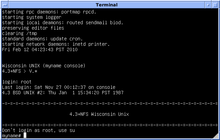| Developer(s) | Robert M. Supnik |
|---|---|
| Initial release | 1993[1] |
| Stable release | 3.12-3[2] |
| Repository | |
| Written in | C |
| Operating system | Windows, Linux, macOS, FreeBSD, OpenBSD, NetBSD, OpenVMS |
| Platform | x86, IA-64, PowerPC, SPARC, ARM |
| Type | Hardware virtualization |
| License | BSD-style licenses |
| Website | simh |
SIMH is a free and open source, multi-platform multi-system emulator. It is maintained by Bob Supnik, a former DEC engineer and DEC vice president, and has been in development in one form or another since the 1960s.
History
[edit]SIMH was based on a much older systems emulator called MIMIC, which was written in the late 1960s at Applied Data Research.[1] SIMH was started in 1993 with the purpose of preserving minicomputer hardware and software that was fading into obscurity.[1]
In May 2022, the MIT License of SIMH version 4 on GitHub was unilaterally modified by a contributor to make it no longer free software, by adding a clause that revokes the right to use any subsequent revisions of the software containing their contributions if modifications that "influence the behaviour of the disk access activities" are made.[3] As of 27 May 2022, Supnik no longer endorses version 4 on his official website for SIMH due to these changes, only recognizing the "classic" version 3.x releases.[4]
On 3 June 2022, the last revision of SIMH not subject to this clause (licensed under BSD licenses and the MIT License) was forked by the group Open SIMH, with a new governance model and steering group that includes Supnik and others. The Open SIMH group cited that a "situation" had arisen in the project that compromised its principles.[5]
Emulated hardware
[edit]


SIMH emulates hardware from the following companies.
Advanced Computer Design
[edit]- PDQ-3
AT&T
[edit]BESM
[edit]Burroughs
[edit]Control Data Corporation
[edit]Data General
[edit]Digital Equipment Corporation
[edit]GRI Corporation
[edit]Hewlett-Packard
[edit]Honeywell
[edit]- H316
- H516
Hobbyist projects
[edit]IBM
[edit]Intel
[edit]- Intel systems 8010 and 8020
Interdata
[edit]- 16-bit series
- 32-bit series
Lincoln Labs – MIT Research Lab
[edit]Manchester University
[edit]MITS
[edit]- Altair 8800 both Intel 8080 and Zilog Z80 versions
Norsk Data
[edit]Royal-Mcbee
[edit]- LGP-30
- LGP-21
Sage Computer Technology
[edit]- Sage II
Scientific Data Systems
[edit]SWTPC
[edit]Systems Engineering Laboratories
[edit]- SEL-32 both Concept-32 and PowerNode systems
Xerox Data Systems
[edit]References
[edit]- ^ a b c "Preserving Computing's Past: Restoration and Simulation" Max Burnet and Bob Supnik, Digital Technical Journal, Volume 8, Number 3, 1996.
- ^ "Release 3.12-3". 31 January 2023. Retrieved 24 February 2023.
- ^ "simh repo: Add top level COPYRIGHT and LICENSE files · simh/simh@ce2adce". GitHub. Retrieved 2022-06-04.
- ^ "SimH "Classic"". simh.trailing-edge.com. Retrieved 2022-06-04.
The V4 GitHub repository has been placed under a modified license that effectively makes it closed source. It will no longer be referenced here.
- ^ "simh@groups.io | Announcing the Open SIMH project". 2022-06-03. Retrieved 2022-06-04.
- ^ "Altair Other Operating Systems".
Well, that’s interesting to know that Psilotum nudum are known as whisk ferns. Psilotum nudum is the commoner species of the two. While the P. flaccidum is a rare species and is found in the tropical islands. Both the species are usually epiphytic in habit and grow upon tree ferns. These species may also be terrestrial and grow in humus or in the crevices of the rocks.
View the detailed Guide of Psilotum nudum: Detailed Study Of Psilotum Nudum (Whisk Fern), Classification, Anatomy, Reproduction